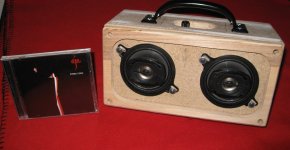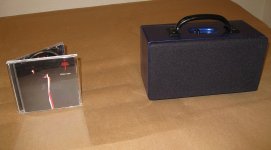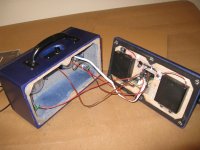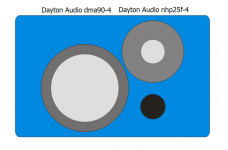Hi everyone,
I'm an absolute beginner with the idea to build a small portable bluetooth speaker and I'd appreciate some input on my ideas!
These are my tentative specifications:
First of all, I've read in other threads that it's difficult to achieve similar sound quality / range to commercial products, as they use DSPs.
Is that true? I would like to get somewhat comparable results from my speaker.
I was thinking a 2-way, with a mid-/fullrange and a tweeter. I assume higher sensitivity is preferable as it's battery powered? Any suggestions for combos?
As far as I know vented speakers can be smaller and can produce lower frequencies. My personal (unqualified) choice would be a passive radiator, mostly because of looks but also because it can be even smaller than ported. I'm happy to use a port as well though, if it brings advantages.
I'd probably use plywood for the enclosure, how thick would it need to be for a small speaker like this?
That's pretty much where I'm at, I'd love to hear your opinions and ideas!!
Thanks in advance!
I'm an absolute beginner with the idea to build a small portable bluetooth speaker and I'd appreciate some input on my ideas!
These are my tentative specifications:
- very portable: around 1l net volume
- mono (I assume one bigger driver is better than two small ones?)
- 2-way
- vented
- casual listening to music and watching movies
- bluetooth and Aux input
- battery powered
- USB chargeable
- overall budget up to around A$150. Flexible if there is a good reason.
First of all, I've read in other threads that it's difficult to achieve similar sound quality / range to commercial products, as they use DSPs.
Is that true? I would like to get somewhat comparable results from my speaker.
I was thinking a 2-way, with a mid-/fullrange and a tweeter. I assume higher sensitivity is preferable as it's battery powered? Any suggestions for combos?
As far as I know vented speakers can be smaller and can produce lower frequencies. My personal (unqualified) choice would be a passive radiator, mostly because of looks but also because it can be even smaller than ported. I'm happy to use a port as well though, if it brings advantages.
I'd probably use plywood for the enclosure, how thick would it need to be for a small speaker like this?
That's pretty much where I'm at, I'd love to hear your opinions and ideas!!
Thanks in advance!
Last edited:
Here's a small boombox that I made. It uses a stereo amp module, and a pair of 3.5" coax car audio speakers. (not mono) Rear panel is removeable.
There are a lot of options for amp module boards to choose from (mono, stereo, 2.1, bluetooth, rechargeable batteries, etc.), and kit packages with everything you need for your own custom assembly. Dayton (PE), Sure, etc. are some to look at.
Happy building!
There are a lot of options for amp module boards to choose from (mono, stereo, 2.1, bluetooth, rechargeable batteries, etc.), and kit packages with everything you need for your own custom assembly. Dayton (PE), Sure, etc. are some to look at.
Happy building!
Attachments
In answer to three of your four questions:I've read in other threads that it's difficult to achieve similar sound quality / range to commercial products, as they use DSPs. Is that true?
I assume higher sensitivity is preferable as it's battery powered?
I'd probably use plywood for the enclosure, how thick would it need to be for a small speaker like this?
1. That is true. Small commercial products can fool us into hearing bass that is not actually there by adding harmonic frequencies that are not present in the original sound. Our hearing analyses these harmonics and reconstructs the missing bass notes in our minds.
2. Higher sensitivity drivers will produce more sound per watt which will save on battery power.
3. 12mm thick should be sufficient as small boxes are inherently strong.
P.S. 1 litre is a very small box. A shoe box is around 8.7 litres
very portable: around 1l net volume
mono (I assume one bigger driver is better than two small ones?)
2-way
vented
casual listening to music and watching movies
bluetooth and Aux input
battery powered
USB chargeable
overall budget up to around A$150. Flexible if there is a good reason.
I think you need to redefine your requirements. 2-way, vented, 1L don't mix very well together.
The only reason for a 2-way is in the use of a mid-bass driver that can't work full-range by itself thus needing a tweeter. There are 3" full-range drivers that can suit your needs without a tweeter. If you want a 2-way the smallest mid is a 4-4.5" driver, I build a speaker in the past with a 4" mid and a 3/4" tweeter, and the net volume was something less than 4L with a 15x23.5 cm baffle.
Venting a speaker is useful for bass extension, but with a driver that can work in both sealed and vented enclosure (Qts around 0.4 or slightly less), the vented enclosure is always bigger than the sealed one. There is a trick for better bass extension with a sealed enclosure, using a very big cap in series with the mid-woofer.
With very small enclosure sometimes it can be impossible to use a vent to correctly tune the enclosure as it won't fit inside, so you need to use a passive radiator instead. A radiator has the disadvantage of the price.
One last point: if you want a 2-way you need to design also a crossover, but if you don't have the skill as it seems from your questions, it is far better to build an already designed speaker.
Ralf
The method of calculating for a passive radiator may appear quite daunting to a beginner:My personal (unqualified) choice would be a passive radiator
Passive Radiator Calculator
Passive radiator speaker design - Box calculation example
Thanks Dave!Here's a small boombox that I made. It uses a stereo amp module, and a pair of 3.5" coax car audio speakers. (not mono) Rear panel is removeable.!
If I wanted mono and a smaller size, I guess I could just cut it in half?
General question, I thought you'd need a divider between the drivers for stereo?
Thanks Galu! So would it be a last cause wanting to build an very small speaker that's somewhat comparable?1. That is true. Small commercial products can fool us into hearing bass that is not actually there
Thanks Ralf, that makes sense.The only reason for a 2-way is in the use of a mid-bass driver that can't work full-range by itself thus needing a tweeter.
Could you elaborate on that please?There is a trick for better bass extension with a sealed enclosure, using a very big cap in series with the mid-woofer.
I'm not too worried about the price, I think it would fit in my budget.so you need to use a passive radiator instead. A radiator has the disadvantage of the price.
I wouldn't mind that, but unfortunately I haven't found anything this small. I could probably go a little bit bigger, but I want to keep it very compact as I'm travelling around for work.it is far better to build an already designed speaker.
Thanks for the links Galu!The method of calculating for a passive radiator may appear quite daunting to a beginner:
It does look like a great speaker! But even if cut in half to make it mono it's too big for my purposes. Thanks anyway!Have a look at Dayton Audio MKBoom portable bluetooth speaker kit.
You have conflicting design criteria, as small as 1 litre of internal volume, higher sensitivity, passive radiator should be of larger Sd (cm2) than driver to have any chance of properly working and this occupies baffle area. Try to define outer cabinet measures as large as you will have it, panel thickness and I'll see if I can come up with a reasonable suggestion for a micro 2 way PR supported. And you show us where do you intend to source driver parts from and their respective datasheet.
This link is a good read for a small enclosure and Passive radiator.
However I am not sure it details the actual passive radiator used, and I haven't checked if the driver is still available.
https://www.tectonicaudiolabs.com/w...gn-for-TEBM35C10-4-BMR-Driver_WSG_12OCT18.pdf
However I am not sure it details the actual passive radiator used, and I haven't checked if the driver is still available.
https://www.tectonicaudiolabs.com/w...gn-for-TEBM35C10-4-BMR-Driver_WSG_12OCT18.pdf
I think everyone will agree that it is not possible to get bass out of a 1 litre enclosure without some form of electronic trickery.Thanks Galu! So would it be a last cause wanting to build an very small speaker that's somewhat comparable?
I would accept Lojzek's offer and tell him how large you are prepared to go.
You have conflicting design criteria, as small as 1 litre of internal volume, higher sensitivity, passive radiator should be of larger Sd (cm2) than driver to have any chance of properly working and this occupies baffle area. Try to define outer cabinet measures as large as you will have it, panel thickness and I'll see if I can come up with a reasonable suggestion for a micro 2 way PR supported. And you show us where do you intend to source driver parts from and their respective datasheet.
Thanks Lojzek, that's very kind of you!
I'm happy to change some parameters! I'm also not married to the 2-way idea, if you think a fullrange speaker makes more sense.
Just to have some measures (external) to work with:
W: 20cm, H: 12.5cm, D: 10cm
panel thickness: 12mm, as Galu suggested
This website seems to have a reasonable selection of parts: Speaker Drivers | Wagner Online Electronic Stores
Hvala!
Last edited:
raymondj's contribution shows a driver/passive radiator combination which gives good upper bass response in a 0.6 litre enclosure.
Note, however, that this requires electronic equalisation to be implemented on the DSP of the amplifier module.
EDIT: I've just seen your reply to Lojzek as I was occupied reading raymondj's contribution!
The information you have included will be most helpful.
Note, however, that this requires electronic equalisation to be implemented on the DSP of the amplifier module.
EDIT: I've just seen your reply to Lojzek as I was occupied reading raymondj's contribution!
The information you have included will be most helpful.
Last edited:
raymondj's contribution shows a driver/passive radiator combination which gives good upper bass response in a 0.6 litre enclosure.
Note that this requires electronic equalisation to be implemented on the DSP of the amplifier module.
That seems really cool, but I'm not sure if I'd be able to reproduce their results. I don't have any tools for measurement.
Reading that document I'm wondering though if I can reduce the wall thickness and add bracing instead. These 12mm walls eat up a lot of volume!
Thanks Dave!
If I wanted mono and a smaller size, I guess I could just cut it in half?
General question, I thought you'd need a divider between the drivers for stereo?
I made the size of the box just big enough to house all of the components, and still easy enough to assemble or disassemble to access everything. Sound quality was quite good even without a separate compartment for each driver.
That would make sense.I'm wondering though if I can reduce the wall thickness and add bracing instead. These 12mm walls eat up a lot of volume!
I suggested 12mm while thinking of a larger, shoe box size enclosure.
Dayton Audio DMA90-4 offers good sensitivity, decent wide band capability. Simulation in 1.7 litres cabinet (8mm panel thickness), vented, tuning frequency Fb=75 Hz (vent 1" by 5.6" in L shape to fit better) should provide you with cut-off frequencies F3/F6/F10=98/77/61 Hz. There is absolutely no need for a PR plus the vent works better in this example, compared to dma90pr and dma105pr. Internal volume is still too small, 2.5 litres and the same Fb=75Hz (vent 1" by 3.5") achieves F3/F6/F10=75/64/56 Hz.
I would advise to first try this drive unit and the 2 way option leave for later if HF performance proved to be inadequate.
I would advise to first try this drive unit and the 2 way option leave for later if HF performance proved to be inadequate.
Attachments
Last edited:
Another option might be TB W3-2141 (3" FR) that will fit in the enclosure that you mentioned above. (12.5cm x 20cm x 10cm)
Vented:
1.3 L ,
Fb = 80 Hz, Port .75" x 3.5"
F3 = 85Hz, F6 = 72 Hz, f10 = 61 Hz
PR - using two (2) DMA90-PR
1.3 L
Fb = 80 Hz
F3 = 118 Hz, F6 = 95 Hz, F10 = 74 Hz
Advantage of using the TB 3" is that it will fit your enclosure. If made with .50" thick material the internal volume would yield 1.3 liter internal volume. Using .38" material will likely offset the displacement of the large magnet on the TB, making the net internal volume close to 1.3 liters.
Disadvantage is that the W3-2141 costs more ($33.40 currently at PE).
Two of the DMA90-PR passive radiators will cost $14.98 at PE currently.
Advantages of using a single DMA90-4 (3.5") driver with vent is it's definitely more cost effective ($13.98 currently), and also the 3.5" has a bit more surface area than the 3".
The advantage of using PR's is that active EQ can be used below the tuning frequency, but not usually recommended for a vented box. Not sure if all surfaces of your intended enclosure are open. the W3 and 2 PRs won't all fit on the same surface.
Plenty of options and compromises.
Vented:
1.3 L ,
Fb = 80 Hz, Port .75" x 3.5"
F3 = 85Hz, F6 = 72 Hz, f10 = 61 Hz
PR - using two (2) DMA90-PR
1.3 L
Fb = 80 Hz
F3 = 118 Hz, F6 = 95 Hz, F10 = 74 Hz
Advantage of using the TB 3" is that it will fit your enclosure. If made with .50" thick material the internal volume would yield 1.3 liter internal volume. Using .38" material will likely offset the displacement of the large magnet on the TB, making the net internal volume close to 1.3 liters.
Disadvantage is that the W3-2141 costs more ($33.40 currently at PE).
Two of the DMA90-PR passive radiators will cost $14.98 at PE currently.
Advantages of using a single DMA90-4 (3.5") driver with vent is it's definitely more cost effective ($13.98 currently), and also the 3.5" has a bit more surface area than the 3".
The advantage of using PR's is that active EQ can be used below the tuning frequency, but not usually recommended for a vented box. Not sure if all surfaces of your intended enclosure are open. the W3 and 2 PRs won't all fit on the same surface.
Plenty of options and compromises.
Last edited:
I'll put some more thought into it and figure out what electronic components I need to get.
I have spotted well looking bits you might want to check.
- Wondom JAB2v2; 1 x 60 Watt Class D Audio Amplifier Board with Bluetooth V5.0 & DSP
- Wondom AA-JA11113; 3S18650 Lithium battery board
- Wondom AA-JA11114; Cables Package for JAB (JAB accessories)
- Wondom AA-JA11115; L-style Aluminum Bracket in 3.6’’ x 2.7’’ size
- Home
- Loudspeakers
- Multi-Way
- Help with a small portable bluetooth speaker



